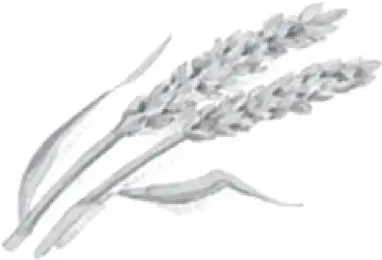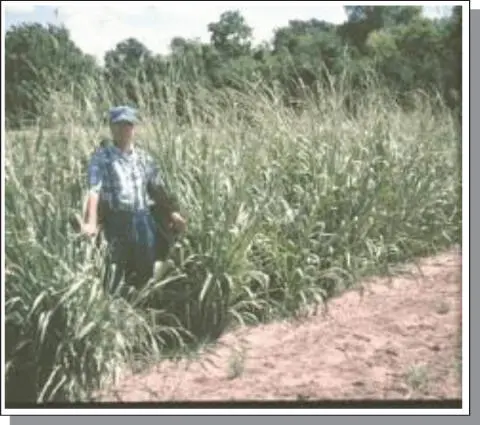 Industry highlights Maize and Tripsacum : experiments in intergeneric hybridization and the transfer of apomixis
Industry highlights Maize and Tripsacum : experiments in intergeneric hybridization and the transfer of apomixis
Bryan Kindiger
USDA‐ARS, Grazinglands Research Laboratory, 7207 West Cheyenne St., El Reno, OK 73036 USA
Research in maize‐ Tripsacum hybridization is extensive and encompasses a period of more than 60 years of collective research. A vast amount of literature exists on various facets of this type of hybridization ranging from agronomy, plant disease, cytogenetics, breeding, and genetic analysis. Consequently, no single article can cover all the research relevant to this topic. This report will not address all the various issues, but focus primarily on specific research and experiments which would perhaps be of value to a student interested in this topic. The interested student is encouraged to review the references below and follow the additional references cited by the various authors to obtain more information on this topic.
Interspecific hybrids, or hybrids generated between species, are utilized by plant breeders to discover and transfer genes from one plant to another plant of a related species which cannot be found in the particular species of interest. One of the most interesting instances of interspecific hybridization is that between maize ( Zea mays L.) and its most distant relative gamagrass ( Tripsacum spp.). Tripsacum L. is a perennial, warm season bunch grass found throughout most of the subtropical and tropical regions of the Western Hemisphere (de Wet et al. 1981, 1982) ( Figure B6.1).

Figure B6.1A stand of Tripsacum dactyloides (eastern gamagrass) in Woodward, County, OK, USA. Individual standing in the gamagrass is Dr. Victor Sokolov, Institute of Cytology and Genetics, Novosibirsk, Russia.
Approximately 16 species have been classified taxonomically in Tripsacum . The most common species is Tripsacum dactyloides L. that can be found growing in much of the USA, Mexico, Central America, and South America (de Wet et al. 1981, 1982). The most commonly studied maize‐ Tripsacum interspecific hybrids are those generated between diploid maize (2n = 2x = 20) and tetraploid Tripsacum dactyloides (2n = 4x = 72). Regardless of their complete difference in chromosome number, plant phenotype, and environmental niche, hybrids are relatively easy to generate.
In 1939, Mangelsdorf and Reeves published their historical monograph “The Origin of Indian Corn and Its Relatives,” in which they discussed their research and views on the relationship of cultivated Zea mays to its distant cousins, teosinte (the closest relative of maize) and Tripsacum spp. (Mangelsdorf and Reeves 1939). Though these early views regarding the origins of maize and its relationship to teosinte and Tripsacum are controversial and are open to discussion and further investigations, the procedures for generating such interspecific hybridizations remains relatively unchanged.
Generating maize × Tripsacum hybrids
Typically, the generation of a maize × Tripsacum hybrid is accomplished by covering the developing maize ear with a bag to prevent cross‐contamination with corn pollen. Within a few days, ample silks are available on the ears and the silks are cut back to approximate 10–15 cm in length. Tripsacum pollen is gathered and dusted onto the maize ear. Typically, pollen from tetraploid Tripsacum (2n = 4x = 72) provides superior seed set, but occasionally, a diploid Tripsacum genotype (2n = 2x = 36) can be identified which also conditions superior seed development. When an appropriate maize genotype is utilized, embryo rescue techniques are not necessary. Experience has shown that a “Supergold popcorn” accession (PI222648) available from the USDA‐ARS Plant Introduction Station, Ames, IA, gives abundant and viable F 1seeds (Kindiger and Beckett 1992) ( Figure B6.2). Experimentation with other maize germplasm can provide similar if not superior results.

Figure B6.2Hybrid seed set utilizing Ladyfinger popcorn as the maternal parent when pollinated by tetraploid T. dactyloides . Over 100 F 1seeds can be readily obtained when an appropriate maize parent is utilized in the cross.
The F 1hybrids are completely pollen sterile and microsporogenesis is associated with a varying array of meiotic anomalies (Kindiger 1993) and vary in seed fertility from completely sterile to highly seed fertile (Harlan and de Wet 1977). To date, all seed fertile hybrids generated from tetraploid Tripsacum dactyloides resources exhibit some level of apomictic expression, which following backcrossing with maize, is often lost. The most common or sexual pathway of genomic change in a series of maize‐ Tripsacum backcross hybrids has been clearly described by Harlan and de Wet (1977). Comparative genetics and other approaches that may result in the transfer of Tripsacum traits to maize, including apomixis are described below.
Gene transfer from Tripsacum to maize
Recent and past research strongly suggests that there is little homeology between the genomes of Tripsacum and maize. Maguire (1962), utilizing a set of recessive phenotypic maize markers, suggested that only maize chromosomes 2, 5, 8, and 9 have a potential for pairing and recombination and for gene introgression with Tripsacum . Additional research has confirmed conservation of loci specific to pistil development between maize and Tripsacum genomes (Kindiger et al. 1995; Li et al. 1997). Maguire (1957, 1960) successfully generated and identified a naturally occurring recombination event between an unknown Tripsacum chromosome and the short arm of maize chromosome 2. Studies using B‐A translocation deletion lines suggested that the Mz9S region could pair and recombine with Tripsacum chromosome 5. Genomic in situ hybridization (GISH) studies have also strongly suggested that only three regions of maize chromosomes have homeology with the Tripsacum genome: the sub‐terminal regions of Mz2S, Mz6L, and Mz8L (Poggio et al. 1999). These regions correspond well with groups of conserved restriction fragment length polymorphism (RFLP) markers identified between maize and Tripsacum genomes (Blakey et al. 1994; Leblanc et al. 1995). As a consequence, few sites are available for Tripsacum introgression into the maize genome and, to date, only two instances are known where verifiable recombination/translocation events have occurred (Maguire 1962; Kindiger et al. 1996b).
Potential pathways for Tripsacum introgression
The 28→38→20 Non‐apomictic pathway
This pathway is the earliest known pathway of maize‐ Tripsacum hybridization first reported by Mangelsdorf and Reeves (1939) and repeated by several others. When crossing a diploid maize (2n = 2x = 20Mz) by a diploid Tripsacum (2n = 2x = 36Tr), the F 1hybrid consists of 10Mz + 18Tr chromosomes. Backcrossing this hybrid by diploid maize typically results in the fertilization of an unreduced egg by the pollen source. This partially apomictic event (a 2n + n mating) results in what is called a B IIIderived hybrid (Bashaw and Hignight 1990) and now possesses 20Mz + 18Tr chromosomes. This behavior is also commonly observed in apomictic tetraploid Tripsacum dactyloides (Kindiger and Dewald 1997) which raises an interesting question regarding the potential of diploid Tripsacum to possess, but not utilize the mechanisms of apomictic reproduction. In a subsequent backcross of this 38‐chromosome individual with diploid maize, individuals possessing 20Mz + 1 thru 17Tr. chromosomes are generated. In some instances, the maize constitution can also be slightly aneuploid, 20 + 1 or 2 maize chromosomes. At this point, the predisposition of these individuals is to rapidly lose most if not all of their Tripsacum chromosomes following additional backcrossing. The end result of continued backcrossing with maize is the recovery of maize, often completely lacking any level of Tripsacum genome introgression through homoeologous pairing and/or recombination. Though, in this pathway, Tripsacum introgression is rare, a method for enhancing the opportunity for introgression has been suggested but not pursued (Kindiger and Beckett 1989).
Читать дальше

 Industry highlights Maize and Tripsacum : experiments in intergeneric hybridization and the transfer of apomixis
Industry highlights Maize and Tripsacum : experiments in intergeneric hybridization and the transfer of apomixis












